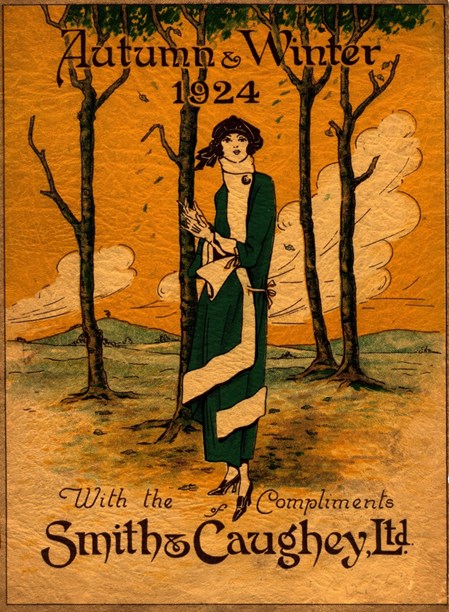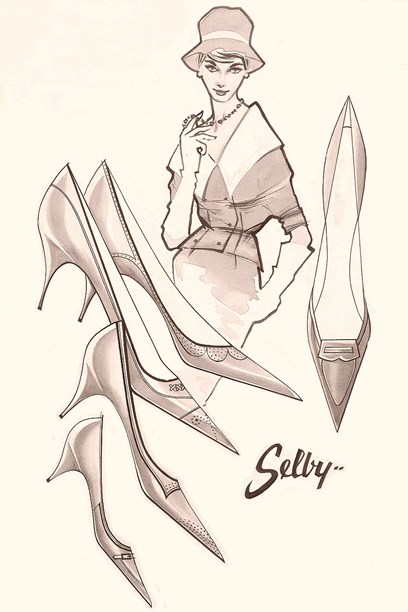Stories
Fashion Illustration in Advertising
Late 1800s–1990

Like starched nylon petticoats, seamed stockings and cloche hats, hand-drawn fashion advertisements have been consigned to the closet of memories. Yet it wasn’t all that long ago that retail stores relied almost solely on fashion drawings to sell their merchandise in newspaper advertisements, magazines and seasonal catalogues.
While smaller fashion stores availed themselves of the services of advertising agencies, independent art studios or newspaper art departments, New Zealand’s larger department stores, in line with their overseas counterparts, had their own advertising departments. The volume of newspaper ads that were produced for fashion and other goods, often three or four a week, justified the employment of full-time commercial artists and copywriters. Having the work done in-house also meant that each store had its own unique illustrative style.

Cover of Smith & Caughey’s Autumn/Winter catalogue, 1924.
The main qualifications for a commercial fashion artist were skills in freehand figure drawing and the ability to create a black and white image, so evocative that readers could imagine the garments or accessories in reality and in colour and aspire to own them. To capture the hang of a sleeve, the drape of a fabric, the fit of a jacket or the tilt of a hat, the clothes were sketched on plaster-of-Paris mannequins and display heads.
Margaret Cross (later Chapman, now Halcrow-Cross) fashion artist and head of the advertising department at The DIC in Dunedin in the early 1960s, says she was taught to draw figures eight heads high but that they were always slightly out of proportion to produce "a more elegant, elongated effect." She initially sketched a 'rough’'which, together with the layout and copy, had to be approved by management before she did the finished art.

Original artwork by Margaret Halcrow-Cross for Selby shoe advertisement, Harris & Sons, Dunedin, late 1950s.
In a 30-year career as a commercial fashion artist, working for fashion and footwear retailers and fashion designers in Dunedin, Wellington and Christchurch, Margaret Halcrow-Cross says she never got bored. "I always loved clothes so drawing them had a double appeal. Fashion never stood still. You never knew what was around the corner. Every season produced something new and different and that was exciting."
American department store advertisements, particularly those in the New York Times, were one of the main sources of inspiration for retail fashion artists in New Zealand throughout the 1950s and 1960s. At The DSA, another major Dunedin department store (like The DIC, now closed), fashion ads from stores such as Saks Fifth Avenue, Bergdorf Goodman, Gimbels, Bonwit Teller, Bloomingdales and Lord & Taylor were carefully cut out and filed, according to clothing category, for future reference. Margaret, who also looked to the New York Times for ideas, cites Gimbels’ artist as her favourite. "He used textured paper and a type of crayon or pencil that produced a grainy effect, creating a line drawing with tone in one hit, thus eliminating the need for a watercolour wash. His style of drawing was unique."
The technique adopted by the majority of New Zealand department store artists in the 1950s involved the use of black ink and a grey wash.
Complementing the work of in-store artists were supplied advertisements featuring international and local fashion labels. These came direct from the company of origin, with the artwork complete and space provided for the given department store’s copy and logo. American swimwear manufacturers Jantzen, Cole of California and Catalina, and New Zealand lingerie company Bendon, were among the brand-conscious labels to supply their own hand-illustrated ads. A number of British firms did likewise.
In 1957 and 1958, Smith & Caughey’s, exclusive Auckland stockists of Christian Dior (made in New Zealand under licence by El Jay), ran two Dior advertisements in Vogue New Zealand. One was for a glamorous evening dress with a matching stole, the other for a smart tailored suit. Rather than being hand-drawn, the fashions were photographed, probably in Paris. The substitution of photographs for drawings may not have seemed significant at the time but it was a sign of things to come.
The growing popularity of photography in advertising in the 1960s led to the eventual demise of hand-drawn fashion ads, which came to be seen as archaic. Although they continued to appear sporadically throughout the 1970s, by the late 1980s they had all but disappeared, having monopolised fashion advertising in New Zealand for more than a century.
Text by Cecilie Geary.
Last published January 2014.